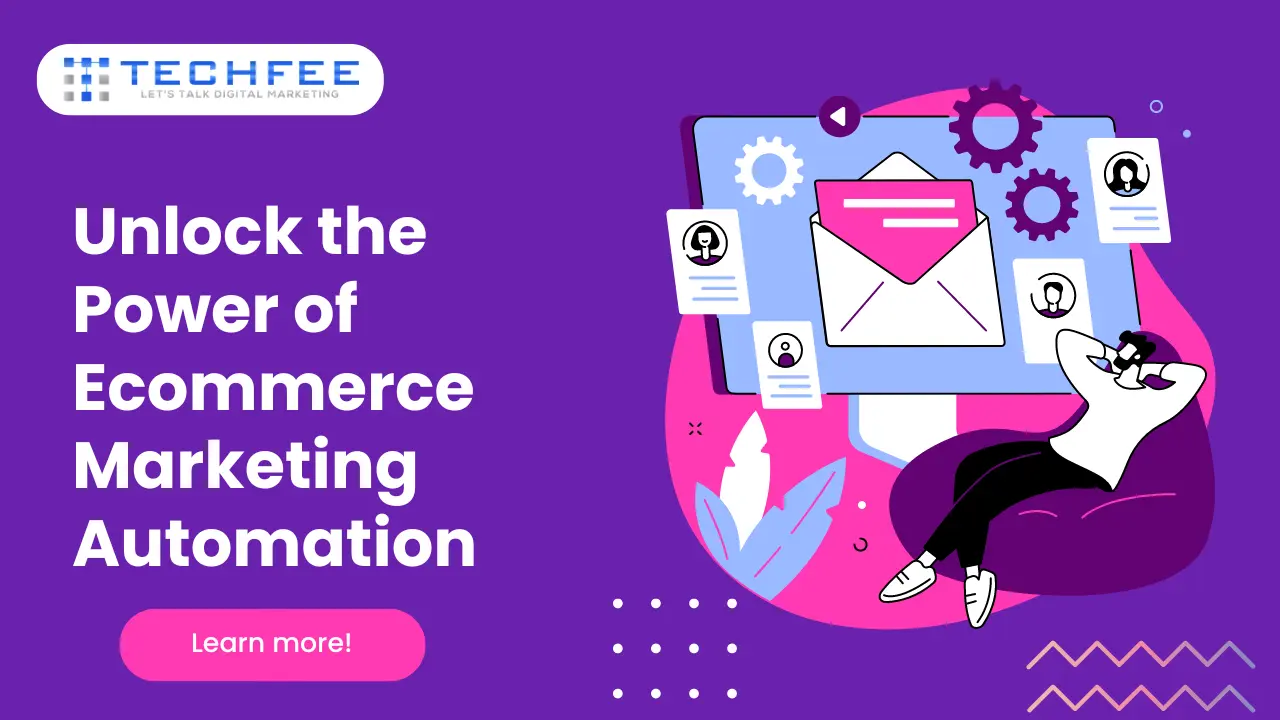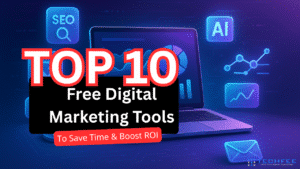To stay ahead of the competition in the fast-paced world of e-commerce, you need more than just a great product. You need a plan for engaging customers at every point of contact. E-commerce marketing automation is a game-changing mechanism transforming how online businesses work.
Imagine making every contact more personal, speeding up your work, and boosting sales around the clock, all without having to do anything.
Automation has never been more critical than now, as e-commerce gets more competitive.
According to WEBFX, 63% of marketers use automation in their email campaigns, which is the most popular marketing channel to automate. 50% of small businesses use marketing automation to run email drip campaigns. 56% of marketers use automation for audience segmentation. 31% of marketers use automation tools to run chatbots on their websites.
That being said, what is marketing automation, and how can it help your company grow?
This post is all about how marketing automation can change things. We’ll look at ten new techniques to help you have the most impact and get measurable results.
These strategies will help you win whether you want to increase customer loyalty, increase conversion rates, or make your ad campaigns more effective.
Are you ready to make your online store grow to its fullest? Let’s get started!
Understanding E-commerce Marketing Automation
A. Definition and Scope
What Is E-commerce Marketing Automation?
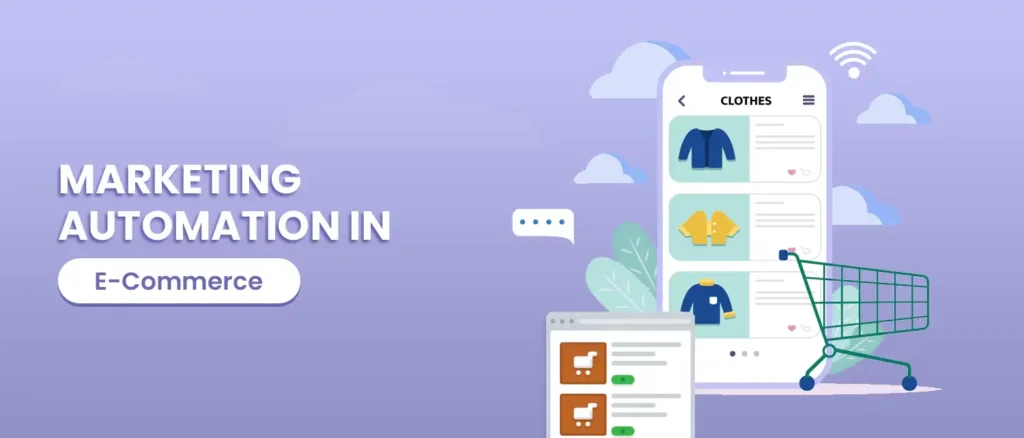
E-commerce marketing automation uses software and technology to streamline, automate, and optimize various marketing tasks and processes within an online retail environment.
It allows businesses to execute marketing campaigns, manage customer interactions, and analyze data with minimal human intervention.
Businesses can focus on strategic activities that drive growth by automating repetitive tasks such as sending emails, segmenting customers, and posting on social media.
E-commerce marketing automation is not just about efficiency; it’s about creating a seamless and personalized experience for each Customer, ultimately leading to increased sales and customer satisfaction.
Key Components of Marketing Automation in E-commerce
The core components of e-commerce marketing automation include email marketing automation, social media automation, SMS marketing automation, customer segmentation, and personalized content delivery.
These elements work together to create a cohesive marketing strategy that is both efficient and effective. Email marketing automation involves sending targeted emails based on customer behavior, while social media automation allows for scheduled posts and real-time engagement.
SMS marketing adds another layer of personalization, delivering timely messages directly to customers’ mobile devices.
Customer segmentation ensures marketing efforts are tailored to specific groups, enhancing relevance and engagement.
These components form a powerful toolkit that helps e-commerce businesses reach their marketing goals.
B. Benefits of Marketing Automation
Efficiency Gains and Time Savings
One of the most significant benefits of e-commerce marketing automation is its tremendous efficiency gains.
By automating routine tasks, businesses can save valuable time that can be redirected toward more strategic initiatives.
For example, automation tools can schedule and send promotional emails based on triggers like customer behavior or specific dates instead of manually sending out promotional emails.
This not only speeds up the process but also ensures consistency and accuracy. Additionally, automation reduces the likelihood of human error, leading to more reliable marketing operations.
Personalization at Scale
In today’s digital landscape, customers expect personalized experiences.
E-commerce marketing automation makes it possible to deliver these experiences on a large scale.
Businesses can create highly targeted campaigns that resonate with individual customers by using data to understand customer preferences and behavior.
Whether it’s personalized product recommendations, tailored email content, or customized offers, automation allows businesses to connect with customers in a personal and relevant way, even when reaching large audiences.
Enhanced Customer Experience

At its core, e-commerce marketing automation is about enhancing the customer experience.
Businesses can build stronger relationships with their customers by providing timely, relevant, and personalized communication.
Automation tools can track customer interactions across multiple channels, ensuring that each touchpoint is optimized for the best possible experience.
Whether through automated follow-up emails, personalized product suggestions, or seamless checkout processes, marketing automation helps create a more engaging and satisfying shopping experience, leading to higher customer retention and loyalty.
Types of E-commerce Marketing Automation

Email Marketing Automation
Email marketing automation is one of the most powerful tools in the e-commerce marketing arsenal.
It allows businesses to send targeted, personalized emails to customers based on their behavior, preferences, and interactions with the brand.
For example, automated email campaigns can be triggered by a customer abandoning their cart, signing up for a newsletter, or making a purchase.
These emails range from welcome messages and product recommendations to follow-up surveys and promotional offers.
By automating these processes, businesses can maintain consistent communication with their customers, nurture leads, and drive repeat sales—all while saving time and resources.
Omnichannel Automation

Omnichannel automation takes customer engagement to the next level by ensuring that your marketing efforts are consistent and cohesive across all channels—email, social media, SMS, or in-store interactions.
This type of automation allows businesses to create a unified customer experience, where each touchpoint reinforces the brand message and moves the Customer further along the purchasing journey.
For example, a customer might receive a promotional email, a personalized social media ad, and an SMS reminder about an ongoing sale—all seamlessly integrated and timed to maximize impact.
Omnichannel automation ensures customers have a smooth, engaging experience, no matter how they interact with your brand.
Improving Workflows
E-commerce marketing automation also plays a crucial role in improving internal workflows. Businesses can streamline their operations, reduce errors, and increase overall efficiency by automating repetitive and time-consuming tasks.
For instance, automation can handle tasks like lead scoring, customer segmentation, and data entry, freeing your team to focus on more strategic activities.
Additionally, workflow automation can ensure that tasks are completed promptly, with notifications and triggers keeping everyone on track.
The result is a more organized and productive marketing process that drives better results.
Optimizing Product Pages
Optimizing product pages is another area where automation can make a significant impact.
Automation tools can help you dynamically update product information, images, and pricing based on customer behavior, inventory levels, or competitive data.
For example, if a particular product is trending, automation can prioritize its visibility on your website, recommend it to relevant customer segments, and even adjust the pricing to maximize profitability.
Automation can also personalize product pages by displaying Content tailored to individual customers, such as related products or customer reviews.
This level of optimization not only improves the shopping experience but also increases the likelihood of conversion.
Optimizing the Checkout Process
The checkout process is a critical stage in the customer journey, and optimizing it through automation can significantly reduce cart abandonment rates and boost sales.
Automated tools can streamline the checkout process by offering features like one-click purchasing, auto-filling customer information, and providing multiple payment options.
Additionally, automation can send real-time notifications to customers about abandoning their carts, offering them incentives like discounts or free shipping to complete their purchases.
By making the checkout process as smooth and effortless as possible, businesses can enhance customer satisfaction and increase the chances of a successful sale.
Critical Components of E-commerce Marketing Automation
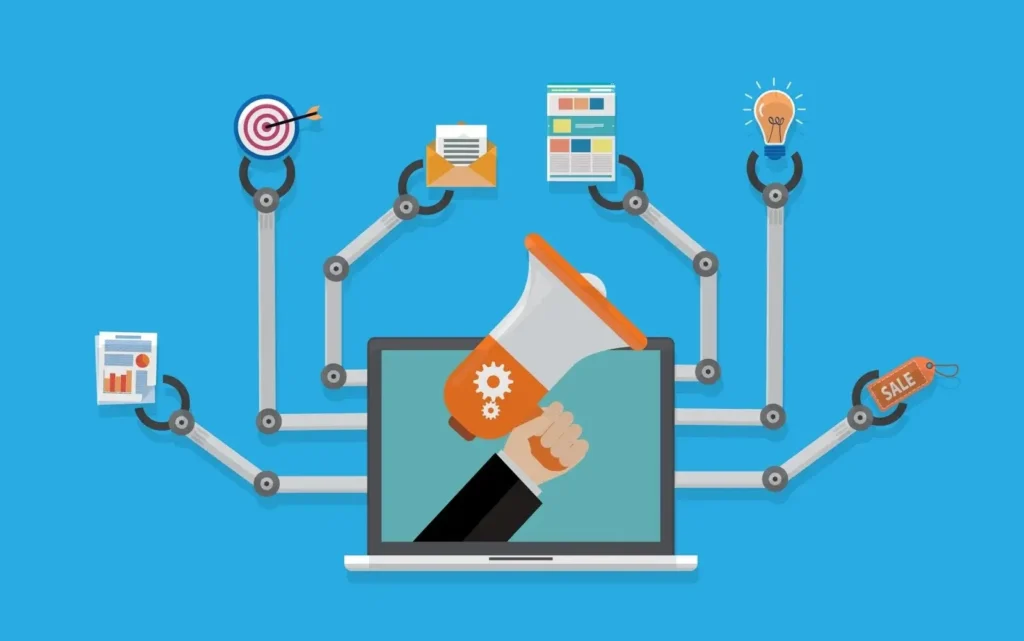
A. Email Marketing Automation
Automated Email Campaigns for E-commerce
Email marketing automation is a cornerstone of e-commerce marketing, enabling businesses to send timely, relevant emails to customers without manual intervention.
Automated email campaigns can be triggered by specific customer actions, such as signing up for a newsletter, abandoning a cart, or purchasing.
These campaigns ensure customers receive the right message at the right time, enhancing engagement and driving conversions.
For instance, a welcome email series can introduce new subscribers to your brand. In contrast, post-purchase emails can offer product recommendations or request feedback, nurturing customer relationships and encouraging repeat business.
Segmentation and Targeted Messaging
Segmentation and targeted messaging are critical to the success of email marketing automation.
By dividing your customer base into distinct segments based on factors such as purchase history, browsing behavior, or demographic information, you can tailor your email content to meet each group’s specific needs and interests.
This personalized approach improves open and click-through rates and increases the likelihood of conversion.
For example, you can create segments for loyal customers, new subscribers, or shoppers who frequently browse without purchasing and send each group customized emails that resonate with their unique preferences and behaviors.
B. Social Media Automation
Scheduling and Posting Automation
Social media is a vital platform for e-commerce businesses, and automating your social media activities can save time while ensuring consistent engagement.
Scheduling and posting automation tools allow you to plan and queue your social media posts in advance, ensuring that your Content is published at optimal times, even outside of regular business hours.
This consistency helps maintain a steady presence on platforms like Instagram, Facebook, and Twitter, keeping your brand top-of-mind for your audience.
Additionally, automated scheduling allows you to manage multiple accounts and campaigns efficiently, ensuring that your messaging remains cohesive across all channels.
Social Listening and Engagement Tools
Beyond posting, social media automation also includes tools for social listening and engagement.
Social listening tools monitor conversations and mentions of your brand across social media platforms, providing valuable insights into customer sentiment and emerging trends.
By automating this process, you can quickly respond to customer inquiries, address concerns, and engage with your audience in real-time.
Engagement tools also allow you to automate responses to common questions or comments, ensuring that your brand remains responsive and connected with customers, even as your social media presence grows.
C. SMS Marketing Automation
SMS Campaign Automation
SMS marketing is a powerful channel for reaching customers directly on their mobile devices, and automating your SMS campaigns can significantly enhance their effectiveness.
With SMS campaign automation, you can send personalized text messages based on customer behavior, such as order confirmations, shipping updates, or promotional offers.
These automated messages are delivered instantly, ensuring timely communication that can drive immediate action.
For example, an automated SMS could remind a customer about an item left in their cart or notify them of a flash sale, prompting a quick response and increasing conversion rates.
Integrating SMS with Other Channels
SMS marketing should be integrated with other marketing channels, such as email and social media, for maximum impact.
Automation tools allow you to coordinate your SMS campaigns with your broader marketing strategy, ensuring that your messaging is consistent and reinforces your brand across all touchpoints.
For instance, follow up a promotional email with an SMS reminder or use SMS to complement a social media campaign.
Integrating SMS with other channels creates a seamless, multi-channel experience that keeps your customers engaged and connected to your brand at every stage of their journey.
E-Commerce Marketing Automation Strategies
Strategy 1: Customer Segmentation and Targeting
A. Importance of Customer Segmentation
Understanding Customer Behavior and Preferences: Customer segmentation is the foundation of effective e-commerce marketing automation.
It involves dividing your customer base into distinct groups based on shared characteristics, such as demographics, purchasing behavior, or browsing patterns.
Understanding customer behavior and preferences through segmentation allows you to tailor your marketing efforts to meet the specific needs of each group.
This personalized approach ensures that your messaging resonates with customers, increasing the likelihood of engagement and conversion.
For instance, by identifying high-value customers who frequently make purchases, you can create targeted campaigns that reward their loyalty while also developing separate strategies for customers who are less active but have the potential to be re-engaged.
B. Tools and Techniques for Effective Segmentation
Using Data to Create Customer Profiles: Creating accurate customer profiles is crucial for effective segmentation.
By leveraging data from various sources, such as purchase history, website interactions, and customer feedback, you can develop detailed profiles that provide insights into who your customers are and what they want.
These profiles help you identify patterns and trends, enabling you to group customers with similar characteristics.
For example, data analysis might reveal a segment of customers who prefer eco-friendly products or who tend to shop during sales events.
With this information, you can craft specific marketing messages that appeal to these preferences, making your campaigns more relevant and effective.
Dynamic Segmentation and Real-time Targeting: Dynamic segmentation takes Customer profiling a step further by allowing you to continuously update and refine your segments in real time based on the latest data.
This approach ensures that your marketing automation remains responsive to changing customer behaviors and preferences.
For example, if a customer who usually shops only during sales suddenly makes a full-price purchase, dynamic segmentation would automatically adjust their profile, enabling you to target them with different offers that encourage further engagement.
Real-time targeting, enabled by dynamic segmentation, allows you to deliver personalized Content at precisely the right moment, such as sending a discount code to a customer actively browsing your site.
This level of precision enhances the customer experience and significantly improves the effectiveness of your marketing efforts.
Strategy 2: Personalized Email Campaigns
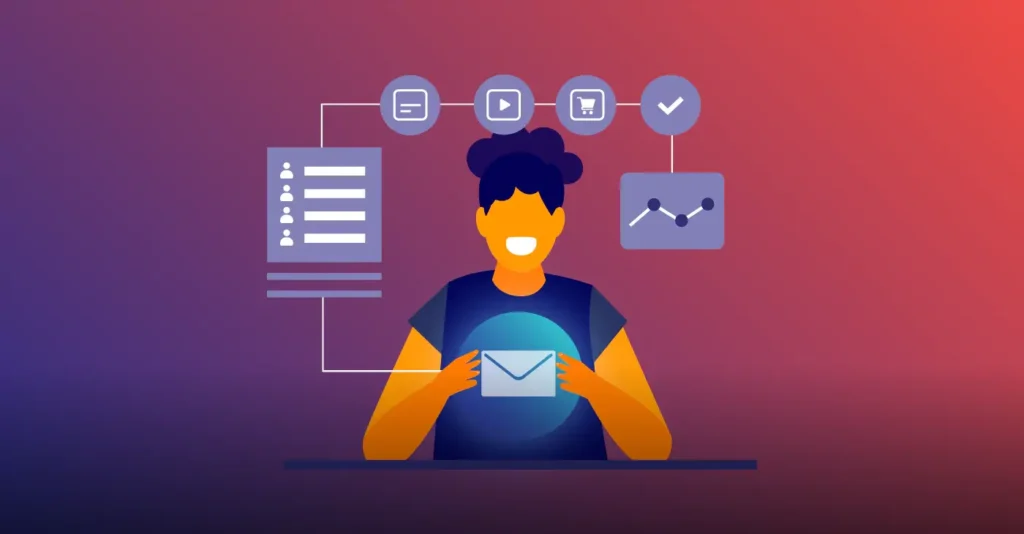
A. Personalization Techniques
Dynamic Content Based on User Behavior: Personalized email campaigns are a powerful tool in e-commerce marketing automation, and dynamic Content is at the heart of this personalization.
By leveraging user behavior data—such as browsing history, past purchases, and engagement with previous emails—you can tailor your emails’ content to match each recipient’s specific interests and needs.
For instance, if a customer frequently browses a particular category on your website, you can include related products or special offers in your emails.
This level of customization not only enhances the relevance of your communications but also increases the likelihood of conversion, as customers are more likely to engage with Content that feels directly relevant to them.
Triggered Emails for Personalized Communication: Triggered emails take personalization a step further by automatically sending specific messages in response to user actions or behaviors.
These emails are designed to be timely and relevant, engaging customers when they are most likely to interact.
For example, if a customer abandons their cart, an automated triggered email can be sent reminding them of the items left behind, possibly with an added incentive like a discount to encourage completion of the purchase.
Similarly, triggered emails can be used to re-engage inactive customers, celebrate birthdays with special offers, or follow up on recent purchases with product recommendations.
You can maintain a continuous and meaningful connection with your customers by automating these personalized touchpoints.
B. Examples of Successful Personalized Campaigns
Case Studies of E-commerce Brands: Many leading e-commerce brands have successfully implemented personalized email campaigns to drive customer engagement and boost sales.
For example, Amazon is renowned for its highly personalized email marketing strategy.
By utilizing customer data to suggest products based on past purchases and browsing history, Amazon sends tailored product recommendations that often lead to increased sales.
Another example is the online fashion retailer ASOS, which uses personalized triggered emails to re-engage customers who have shown interest in specific items but have not yet purchased them.
These emails often include a reminder of the product, a sense of urgency, or a special discount to encourage conversion.
These case studies highlight the effectiveness of personalized email campaigns in creating a more engaging and profitable customer experience.
Strategy 3: Abandoned Cart Recovery Automation
A. Importance of Abandoned Cart Emails
Reducing Cart Abandonment Rates: Abandoned cart emails are one of the most effective tools in e-commerce marketing automation, specifically designed to address the significant issue of cart abandonment.
Studies show that the average cart abandonment rate across all industries is around 70%, meaning a substantial number of potential sales are lost at the final stage of the purchasing process.
Abandoned cart emails serve as a crucial strategy to recover these lost sales by reminding customers of the items they left behind and encouraging them to complete their purchase.
These emails are highly effective because they target customers who have already shown a strong intent to buy, making them more likely to convert with just a gentle nudge.
By reducing cart abandonment rates, these automated emails can significantly increase revenue and improve overall conversion rates.
B. Best Practices for Cart Recovery Emails
Timing, Messaging, and Incentives: To maximize the effectiveness of abandoned cart emails, it’s essential to follow best practices in timing, messaging, and incentives.
Timing is critical—sending the first recovery email within 1-3 hours of cart abandonment is ideal, as the purchase intent is still fresh in the customer’s mind.
A follow-up email 24 hours later can be a reminder if the initial email didn’t prompt action. The messaging in these emails should be clear, concise, and personalized.
Including a compelling subject line, such as “You Left Something Behind!” or “Complete Your Purchase,” can grab the customer’s attention.
The email content should remind customers of the items in their cart, with high-quality images and product descriptions to rekindle their interest.
Incentives can further boost the effectiveness of cart recovery emails. Offering a limited-time discount, free shipping, or a special offer can provide the extra motivation needed for customers to complete their purchases.
Additionally, including customer reviews or ratings of abandoned products can build trust and reinforce the value of the items.
By carefully timing these emails, crafting persuasive messages, and offering appealing incentives, e-commerce businesses can recover a significant portion of abandoned carts and drive more sales.
Strategy 4: Loyalty Programs and Automated Rewards
A. Building Customer Loyalty through Automation

Implementing Automated Rewards and Points Systems: Building customer loyalty is essential for the long-term success of any e-commerce business, and marketing automation plays a pivotal role in this process.
Automated rewards and points systems are powerful tools that can help retain customers by consistently recognizing and rewarding their loyalty.
Through automation, these systems can be seamlessly integrated into the customer journey, allowing businesses to automatically award points for specific actions such as purchases, referrals, or social media engagement.
Customers can then redeem these points for discounts, special offers, or exclusive products, creating a continuous cycle of engagement and incentive to return.
By automating the reward process, businesses not only save time and resources but also ensure that their loyalty programs are consistently applied, making customers feel valued and appreciated at every interaction.
B. Integration with Other Marketing Channels
Cross-channel Promotion of Loyalty Programs: To maximize the impact of loyalty programs, it’s crucial to integrate them across multiple marketing channels, creating a cohesive and omnipresent brand experience.
Cross-channel promotion ensures that customers are consistently reminded of the benefits of the loyalty program, whether they are browsing on your website, checking their email, or engaging with your brand on social media.
For example, automated emails can be sent to notify customers of their current points balance, upcoming rewards, or special promotions available only to loyalty members.
Similarly, social media campaigns can highlight the perks of joining the loyalty program, while SMS notifications can alert customers to exclusive, time-sensitive offers.
By promoting your loyalty program across all channels, you create multiple touchpoints that reinforce its value, encouraging ongoing participation and deeper customer engagement.
This integration not only enhances the effectiveness of the loyalty program but also ensures that it becomes an integral part of the customer’s overall experience with your brand.
Strategy 5: Automated Product Recommendations
A. The Role of AI in Product Recommendations
How AI Enhances Personalization in E-commerce: Artificial Intelligence (AI) plays a transformative role in e-commerce by powering automated product recommendations that significantly enhance personalization.
Through advanced algorithms and machine learning, AI analyzes vast amounts of data on customer behavior, preferences, and purchase history.
This data-driven approach allows AI to predict and suggest products that are most likely to resonate with individual customers, creating a highly personalized shopping experience.
For example, AI can recommend complementary products based on a customer’s recent purchases or suggest items that align with their browsing history and preferences.
These personalized recommendations not only improve the shopping experience but also increase the likelihood of cross-selling and upselling, ultimately driving higher conversion rates and boosting overall sales.
B. Implementing Automated Recommendation Engines
Tools and Platforms for Product Recommendations: Implementing automated recommendation engines requires the right tools and platforms that can seamlessly integrate with your e-commerce system.
Several advanced solutions are available that leverage AI and machine learning to deliver real-time, personalized product recommendations.
Tools like Algolia, Nosto, and Dynamic Yield offer robust recommendation engines that analyze customer data to provide highly relevant product suggestions.
These platforms can be tailored to your specific needs, whether it’s recommending products on your website, through email campaigns, or even via mobile apps.
By deploying these tools, businesses can automate the recommendation process, ensuring that each customer is presented with products that match their unique tastes and preferences.
This not only enhances the user experience but also increases customer satisfaction and loyalty, as shoppers are more likely to return to a site that consistently meets their needs with relevant product suggestions.
Strategy 6: Multi-Channel Marketing Automation
A cohesive multi-channel strategy is essential for e-commerce businesses aiming to maximize customer engagement and conversions.
In today’s digital landscape, customers interact with brands across various platforms, including email, social media, SMS, and websites.
Ensuring consistent messaging across all these channels is crucial for building brand trust and maintaining a seamless customer experience.
When customers receive the same message—whether it’s a promotion, product launch, or brand story—on different platforms, it reinforces the brand’s voice and values, making it more likely to resonate with them and drive action.
This consistency is not just about repeating the same content but tailoring it to fit the context of each channel while maintaining the core message.
To effectively manage and execute a multi-channel marketing strategy, leveraging automation tools is key.
These tools allow businesses to integrate various channels like email, SMS, and social media, ensuring that campaigns are launched simultaneously or in a well-orchestrated sequence.
For example, an e-commerce brand can use a platform that triggers an SMS after a customer receives an email or follows up with a social media ad, creating a cohesive customer journey.
Integrating these tools enables seamless communication, reducing the manual effort required to manage multiple platforms.
By automating these processes, e-commerce businesses can focus on creating impactful content and strategies, knowing that the delivery and timing across all channels are handled efficiently.
Strategy 7: Automated Customer Feedback and Surveys
Automating customer feedback and surveys is a powerful strategy for gathering valuable insights that can significantly enhance the customer experience.
Through automation, e-commerce businesses can seamlessly collect feedback at various touchpoints—after a purchase, following a customer service interaction, or post-visit to a website. Surveys play a crucial role in this process by providing direct insights into customer satisfaction, preferences, and pain points.
When feedback is gathered consistently, it allows businesses to make data-driven decisions that improve product offerings, customer service, and overall user experience.
Automated surveys ensure that this process is efficient and timely, capturing customer sentiments when they are most relevant and likely to respond.
To implement this strategy effectively, utilizing tools designed for survey automation is essential. Platforms like SurveyMonkey, Typeform, and Google Forms offer robust features for automating feedback collection.
These tools can be integrated with your e-commerce system to trigger surveys automatically based on specific actions, such as after a purchase or when a customer abandons their cart.
Additionally, these platforms provide analytics that help businesses understand customer feedback trends, identify improvement areas, and track customer satisfaction changes over time.
Automating the feedback process allows e-commerce businesses to continuously refine their strategies, ensuring they meet customer needs and expectations more effectively.
Strategy 8: Dynamic Pricing Automation
Dynamic pricing in e-commerce is a strategy where the prices of products are automatically adjusted in real-time based on various factors, such as demand, competition, inventory levels, and customer behavior.
This approach allows businesses to remain competitive and maximize revenue by responding swiftly to market changes.
Automated pricing adjustments work by using algorithms that analyze data and apply predetermined rules to alter prices.
For instance, if demand for a product spikes, the system may increase the price to capitalize on the higher interest. Conversely, if a competitor drops their prices, the system can lower yours to maintain a competitive edge.
This real-time adjustment ensures that pricing is always optimized, helping businesses increase sales while maintaining profitability.
Implementing dynamic pricing strategies requires the use of advanced tools and techniques.
Platforms like Prisync, Price2Spy, and RepricerExpress offer sophisticated features for price optimization, enabling e-commerce businesses to monitor market trends and adjust prices automatically.
These tools use machine learning and AI to predict the best pricing strategies based on historical data, current market conditions, and competitor actions.
Additionally, techniques such as segment-based pricing, where prices are adjusted based on customer segments, or time-based pricing, where prices change depending on the time of day or season, can be incorporated into dynamic pricing strategies.
By leveraging these tools and techniques, e-commerce businesses can optimize their pricing models, ensuring they are competitive, responsive, and aligned with their overall business goals.
Strategy 9: Social Proof and Automated Reviews
Leveraging social proof is a critical strategy for building trust and credibility in the e-commerce space, and customer reviews and testimonials are at the heart of this approach.
Social proof refers to the influence that other people’s actions and opinions have on our own decisions.
In e-commerce, displaying customer reviews and testimonials prominently on product pages, landing pages, and throughout the shopping journey can significantly boost consumer confidence.
Positive reviews and testimonials act as endorsements, reassuring potential customers about the quality and reliability of your products.
They help bridge the gap between online shopping and the lack of physical interaction with products, making them essential for driving conversions and reducing cart abandonment.
To maximize the impact of social proof, e-commerce businesses can use automation tools to streamline the process of collecting and displaying reviews.
Platforms like Yotpo, Trustpilot, and Bazaarvoice offer comprehensive solutions for automating review collection and integration. These tools can automatically send review requests to customers after a purchase, encouraging them to share their experiences.
Additionally, they provide features for moderating, displaying, and highlighting the best reviews on your website.
By automating this process, businesses can ensure a steady flow of fresh, relevant reviews that enhance credibility and provide up-to-date social proof.
Moreover, these platforms often include analytics to help you track the performance of reviews and their impact on sales, enabling you to fine-tune your strategy for maximum effectiveness.
Strategy 10: Retargeting and Automated Ad Campaigns

Retargeting is a powerful strategy in e-commerce, enabling businesses to re-engage potential customers who have interacted with their website but haven’t completed a purchase.
Retargeting keeps your brand top-of-mind and nudges customers back to your site by tracking visitors through cookies and displaying targeted ads as they browse other websites or social media platforms.
This method significantly increases conversion rates, as it targets individuals who have already shown interest in your products.
The repeated exposure through retargeting ads can overcome hesitations, remind customers of items they left in their cart, or introduce new offers that encourage them to complete their purchase.
Automating retargeting campaigns takes this strategy to the next level by ensuring that the right ads are shown to the right people at the right time, without the need for constant manual intervention.
Tools like Google Ads, Facebook Ads Manager, and AdRoll offer robust retargeting automation features, allowing you to create dynamic ads that adapt to user behavior.
For example, if a customer views a specific product but doesn’t buy it, these tools can automatically display ads featuring that product or similar ones across the web.
Best practices for effective retargeting include:
- Segmenting your audience based on their behavior.
- Setting frequency caps to avoid ad fatigue.
- Continuously testing ad creatives to see what resonates best with your audience.
Automating these processes allows e-commerce businesses to run highly personalized and efficient retargeting campaigns that drive conversions and maximize ROI.
Best E-commerce Marketing Automation Tools
When it comes to e-commerce marketing automation, selecting the right tools can significantly enhance your business’s efficiency and customer engagement.
Here’s a closer look at some of the best tools available:
1. Insider
Insider is a powerful growth management platform that offers personalized cross-channel experiences.
It excels in segmenting audiences and delivering tailored content through email, SMS, push notifications, and more.
Insider’s AI-driven insights help businesses predict customer behavior and optimize marketing efforts accordingly, making it a top choice for advanced personalization.
2. Omnisend
Omnisend is an all-in-one email marketing automation platform designed specifically for e-commerce.
It integrates seamlessly with online stores and provides robust features for email, SMS, and web push notifications.
Omnisend stands out for its pre-built automation workflows, which allow businesses to quickly set up campaigns like cart abandonment, welcome series, and order confirmation emails.
3. Klaviyo
Klaviyo is known for its deep integration with e-commerce platforms like Shopify and Magento, making it easy to pull in data and create highly targeted campaigns.
Its strength lies in its ability to personalize emails and SMS messages based on customer behavior and purchase history.
Klaviyo also offers powerful segmentation tools, enabling businesses to reach specific customer groups with tailored messages.
4. Drip
Drip is a marketing automation tool tailored for e-commerce brands that want to build strong customer relationships.
It offers sophisticated segmentation, email personalization, and multichannel marketing capabilities.
Drip’s visual workflow builder makes it easy to create complex automation sequences, helping businesses nurture leads and convert them into loyal customers.
5. ActiveCampaign
ActiveCampaign is a comprehensive marketing automation platform that combines email marketing, CRM, and machine learning.
It’s ideal for e-commerce businesses looking to automate their customer journeys, from initial contact to post-purchase follow-ups.
With features like predictive content and advanced segmentation, ActiveCampaign helps businesses deliver the right message at the right time.
Ready to supercharge your e-commerce marketing with ActiveCampaign?
Click here to start your free trial and see how this powerful tool can help you automate your campaigns, boost conversions, and grow your business effortlessly. Don't miss out.
Get Started Today!6. Mailchimp
Mailchimp is one of the most popular marketing automation tools, especially for small to medium-sized e-commerce businesses.
It offers a user-friendly interface and a wide range of features, including email marketing, landing pages, and social media ads.
Mailchimp’s automation capabilities, such as sending targeted emails based on customer behavior, make it a versatile choice for businesses looking to grow their online presence.
7. HubSpot
HubSpot is a leading inbound marketing platform that offers robust automation tools for e-commerce businesses. It provides features like email marketing, social media management, and CRM integration.
HubSpot’s strength lies in its ability to create seamless customer experiences across various channels, from first contact to post-purchase engagement, all while providing detailed analytics to track performance.
8. EngageBay
EngageBay is an affordable marketing automation tool that combines CRM, email marketing, and lead generation.
It’s designed for small businesses looking to automate their marketing efforts without breaking the bank.
EngageBay offers a wide range of automation features, including lead scoring, email sequences, and customer segmentation, making it a strong contender for budget-conscious e-commerce businesses.
9. Brevo (Sendinblue)
Brevo, formerly known as Sendinblue, is a versatile marketing automation platform that offers email marketing, SMS marketing, and chat capabilities.
It’s known for its ease of use and affordability, making it ideal for small to medium-sized e-commerce businesses.
Brevo’s automation features include workflows for email campaigns, transactional messages, and retargeting ads, helping businesses maintain consistent communication with their customers.
Each of these tools brings unique strengths to the table, catering to different business needs and budgets.
Whether you’re looking for advanced personalization, budget-friendly options, or comprehensive marketing suites, these platforms offer robust solutions to enhance your e-commerce marketing automation efforts.
Common Challenges and How to Overcome Them
When implementing e-commerce marketing automation, businesses often face challenges that can hinder the effectiveness of their strategies. One common issue is data integration.
Ensuring a seamless data flow across various systems is crucial for successful automation, but it can be challenging due to the different platforms and tools involved.
Poor data integration can lead to inaccurate targeting, inconsistent messaging, and missed opportunities.
To overcome this, businesses should invest in robust integration solutions that connect all their marketing, sales, and customer service tools.
Using platforms with native integrations or employing middleware solutions like Zapier can help ensure that data is synchronized in real-time, providing a unified view of the customer journey and enabling more effective automation.
Another challenge is the risk of over-automation, where businesses might rely too heavily on automated processes at the expense of personalization.
While automation can streamline marketing efforts, it’s essential to maintain a human touch to keep customers engaged and loyal. Over-automation can lead to impersonal interactions, making customers feel like they are just another number.
To avoid this, businesses should balance automation with personalization by segmenting their audience and tailoring automated messages to individual preferences and behaviors.
Additionally, incorporating occasional personalized, human-written messages and offering easy access to customer support can help maintain that essential human connection.
By addressing these challenges thoughtfully, businesses can fully leverage marketing automation while keeping the customer experience front and center.
Conclusion: E-commerce Marketing Automation
In this comprehensive guide, we’ve explored ten game-changing strategies for e-commerce marketing automation, from customer segmentation and personalized email campaigns to dynamic pricing and retargeting ad campaigns.
Each strategy is designed to help you streamline your operations, enhance customer experiences, and ultimately drive more sales.
By leveraging tools like Insider, Omnisend, and Klaviyo, you can automate these strategies effectively, saving time and resources while achieving consistent results.
As you implement these strategies, it’s crucial to measure your success by tracking key metrics like conversion rates, customer lifetime value, and ROI.
With the right analytics and reporting tools, you can fine-tune your automation efforts to achieve even greater impact.
Looking ahead, the future of e-commerce marketing automation is bright.
As technology continues to evolve, we can expect even more sophisticated tools that offer deeper personalization, smarter AI-driven insights, and seamless integration across all marketing channels.
By staying ahead of these trends and continuously optimizing your automation strategies, you can ensure your e-commerce business remains competitive and thrives in the ever-changing digital landscape.
We’d Love to Hear from You!
What did you think of our guide on e-commerce marketing automation?
Share your thoughts and experiences in the comments below—we’d love to hear how these strategies might impact your business or if you have any additional tips to add!
Don’t miss out on future insights and updates like this. Subscribe to our email newsletter to receive the latest blog posts, expert advice, and exclusive content directly in your inbox.
Stay informed and keep your e-commerce marketing strategies sharp—sign up now!
Frequently Asked Questions on E-commerce Marketing Automation
What is the first step to implementing e-commerce marketing automation?
The first step is to identify your business goals and choose the right automation tools to achieve them.
How can small businesses benefit from marketing automation?
Small businesses can benefit by saving time, improving customer targeting, increasing efficiency, and scaling personalized marketing efforts without additional resources.
What are the best tools for e-commerce marketing automation?
Some of the best tools include ActiveCampaign, Omnisend, Klaviyo, HubSpot, Mailchimp, and Insider.
How can automation improve customer retention?
Automation improves customer retention by delivering personalized experiences, sending timely follow-ups, and maintaining consistent communication through automated loyalty programs and targeted campaigns.
Is there a risk of over-automating marketing efforts?
Yes, over-automation can make interactions feel impersonal, potentially alienating customers. It's important to maintain a balance and include personalized touches.
What is CRM and marketing automation?
CRM (Customer Relationship Management) is a system for managing customer interactions and data, while marketing automation refers to using software to automate marketing tasks, often integrated with CRM to streamline customer engagement.
